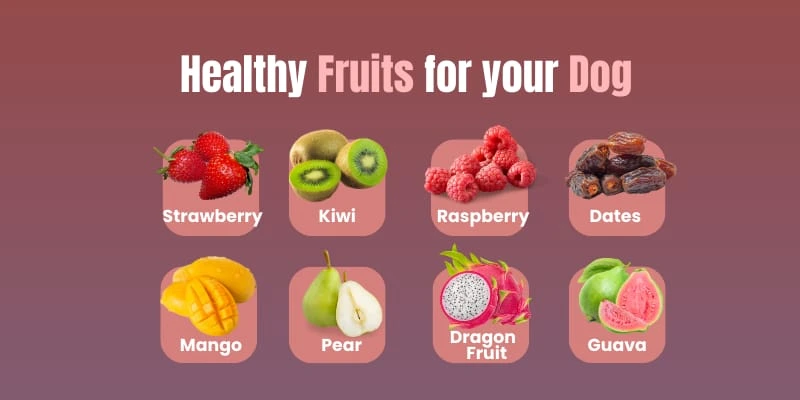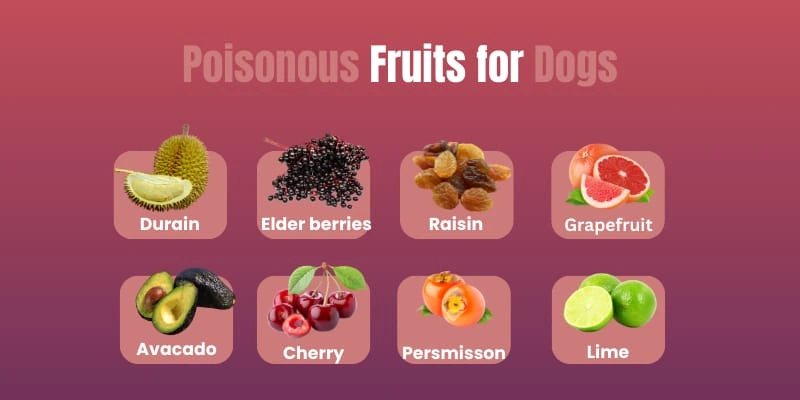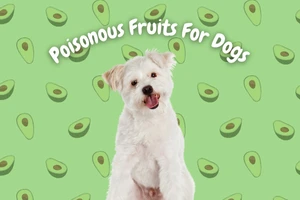Can Dogs Eat Fruits? A Comprehensive Guide
Published: 3 Nov 2024
Imagine eating an apple, and your dog looks at you with innocent, demanding eyes. You may be wondering, should I share it with my dog? Can dogs eat fruits?
It’s hard to resist sharing, but you must be careful because not all fruits are safe for dogs, and some can even hurt them. Knowing which fruits are safe helps you make smart choices for your dog’s health, but it can also be stressful.
In this article, we will discuss which fruits are safe for dogs, how to prepare them, and what benefits they offer for health. We’ll also look at fruits to avoid and offer tips on adding new fruits to your dog’s meals.
So, let’s jump in and see how fruits can make your dog’s diet more fun!
Can Dogs Eat Fruits?
Yes! Dogs can eat fruits, but you must remember that not all fruits are good for them. Fruits contain fiber, vitamins (A, C, and E), antioxidants, potassium, and necessary enzymes. All these nutrients help to improve digestion, boost immunity, promote cell growth, and provide overall health benefits.
While many fruits are safe and healthy for dogs, some can be harmful or toxic. Some fruits contain substances like persin or cyanide that can cause serious health issues in dogs, such as gastrointestinal upset, lethargy, organ failure, or more severe reactions.
Let’s explore together which fruits are safe for our dogs and which are toxic!
Safe Fruits for Dogs
As dog parents, it’s our responsibility to know which fruits are safe for our furry friends to keep them away from hazards.
Here’s a list of fruits that dogs can eat without any worries:
- Apple
- Apricot
- Banana
- Blackberry
- Blueberry
- Cranberries
- Cantaloupe
- Coconut
- Date
- Dragon Fruit
- Fig
- Guava
- Honeydew Melon
- Kiwi
- Mango
- Mulberry
- Nectarine
- Papaya
- Passion Fruit
- Peach
- Pear
- Pineapple
- Plum
- Pomegranate
- Raspberry
- Strawberry
- Tangerine
- Watermelon

Read more about the nutritional benefits of each fruit in detail in our article “Safe Fruits for Dogs.”
Toxic Fruits for Dogs
Dog owners must know these toxic fruits to keep their furry friends safe and healthy.
Here’s a list of toxic fruits to avoid:
- Grapes
- Raisins
- Cherries
- Damsons
- Avocado (the pit and skin)
- Citrus fruits (like lemons, limes, and grapefruit)
- Elderberries
- Durians

You can read all the details in our article “Toxic Fruits for Dogs.
Health Benefits of Fruits for Dogs
Incorporating fruits into your dog’s diet can significantly enhance their nutrition and health. According to the American Kennel Club, fruits keep dogs hydrated and provide essential nutrients. Some key benefits include:
- Vitamins and Minerals: Fruits are rich in essential vitamins like vitamin C and minerals like potassium, supporting the immune system and heart health.
- Antioxidants: Fruits like blueberries contain antioxidants that protect cells from damage and lower the risk of chronic diseases.
- Dietary Fiber: Fiber aids digestion, promotes gut health, and helps prevent constipation.
- Low-Calorie Treats: Fruits are low in calories, making them great alternatives to high-calorie snacks for weight management.
- Hydration: Many fruits have high water content, helping keep your dog hydrated, especially in hot weather.
- Natural Sugars: Fruits provide natural sugars for a quick energy boost during play.
- Skin and Coat Health: Vitamins and fatty acids in fruits promote healthy skin and a shiny coat.
How to Prepare Fruits for Your Dog
Now that you know which fruits are safe and toxic, you can add safe fruits to your dog’s regular diet by following these tips:
- Choose the Right Fruits: Pick dog-safe fruits like apples (no seeds!), blueberries, strawberries, watermelon (remove seeds and rind), and bananas.
- Clean and Freshen Up: Wash all fruits thoroughly to remove dirt and pesticides, ensuring they’re safe for your pup.
- Cut It Right: Slice fruits into small, bite-sized pieces to prevent choking and make them easier for your dog to enjoy.
- Serve Fresh or Chill: On hot days, you can offer fresh fruits or freeze them for a refreshing treat.
- Take It Slow: Introduce new fruits gradually. Start with a small piece and watch for any signs of allergies, like itching or upset stomach.
- Store with Care: To maintain freshness, keep prepared fruits in an airtight container in the fridge. Remember, moderation is key to avoiding tummy trouble!
Creative Ways to Serve Fruits to Dogs
You want to feed your dog fruits, but he’s a picky eater and doesn’t want any. Here are some creative ways to make fruit snacks exciting for your dog:
- Make Popsicles: Blend fruits like bananas or strawberries with yogurt, pour into molds, and freeze. You’ve got delicious and nutritious popsicles that even the pickiest eater would love.
- Create Fruit Treats: Mix pureed fruits into homemade dog biscuits for a tasty snack.
- Serve Frozen Cubes: Freeze pieces of safe fruits in water for refreshing treats on hot days.
- Prepare Fruit Salad: Chop up safe fruits and mix them together for a colorful snack.
- Stuff a Kong: Fill a Kong toy with mashed fruits to keep your dog busy and happy.
With these fun ideas, your dog will enjoy healthy fruits in a whole new way!
How Much Fruit Does a Dog Need?
Fruits can be a healthy addition to your dog’s diet, but moderation is key. Research has shown that the digestive system of dogs works completely differently than that of humans. Here’s a general guideline on how much fruit your dog can safely enjoy:
- Small Dogs (up to 20 lbs): 1 to 2 tablespoons of fruit per day.
- Medium Dogs (20 to 50 lbs): 2 to 4 tablespoons of fruit per day.
- Large Dogs (over 50 lbs): ½ to 1 cup of fruit per day.
Treats, including fruits, should not exceed 10% of your dog’s daily calorie intake. For example, if your dog needs 500 calories daily, fruits should be around 50 calories.
How Would I Recognize Toxic Fruit Consumption in My Dog?
If you think your dog has eaten a toxic fruit, it’s important to watch them for any signs of trouble. Symptoms can show up quickly and vary based on the type of fruit they ate. If you see any strange symptoms, it’s best to call your vet immediately.
Signs of Toxic Fruit Consumption in Dogs:
- Upset stomach (vomiting, diarrhea, drooling)
- Tiredness (unusual weakness or low energy)
- Trouble breathing (fast or hard breathing)
- Changes in behavior (confusion, restlessness)
- Seizures or shaking (nervous system issues)
- Swelling (especially around the mouth or throat)
- Fast or irregular heartbeat
Being aware and acting quickly can help protect your dog if they eat something harmful.
Conclusion
So, guys, you have found the answer to your question, “ Can dogs eat fruits?”.
In conclusion, fruits can be a delightful and healthy addition to your dog’s diet. By knowing which fruits are safe and how to prepare them, you can ensure your furry friend enjoys the benefits while staying secure.
If you introduce new fruit to your dog, constantly monitor it for signs of distress and consult your veterinarian with any questions about its diet. Enjoy feeding your dog safe, healthy fruits!
Share your experiences of feeding fruits to your dog in the comments below. Share what fruits they love the most. Let’s make our furry friends’ lives even better together!
FAQs
Here are the answers to FAQs related to fruits for dogs:
Yes, dogs can eat fruit daily, but it should be in moderation. AKC advises that fruits should only make up about 10% of their daily calorie intake to avoid digestive issues or weight gain.
Yes, some dogs with sensitive stomachs can have allergic reactions to fruits like strawberries, bananas, or kiwi cause they contain higher fibers that might irritate their guts.
Start by giving your dog a small piece of the new fruit and observe how they react. If there are no signs of allergies or digestive issues after 24-48 hours, you can continue adding it to their diet.
It’s best to avoid fruit-flavored snacks as they often contain artificial ingredients and added sugars, which aren’t healthy for dogs. Stick with fresh, natural fruit instead.
Contact your veterinarian immediately if your dog eats a toxic fruit, like grapes or cherries. Symptoms like vomiting, diarrhea, or trouble breathing may indicate an emergency.
Dried fruits are not ideal for dogs as they are high in sugar and can be harder to digest. Stick with fresh fruits for better hydration and easier digestion.
Too much fruit can cause digestive upset in dogs. For small dogs, keep fruit intake to 1 to 2 tablespoons per day and up to ½ cups for large dogs.
Puppies can eat fruits, but you should introduce them gradually and in small amounts. Make sure to cut the fruits into tiny pieces to avoid choking hazards.
Yes, fruits like pumpkin and papaya can help digestion due to their fiber content and natural enzymes. They can help prevent constipation or upset stomachs.
Diabetic dogs should avoid fruits that are high in sugar, like bananas or grapes. It’s best to consult your vet before giving fruits to diabetic dogs.

- Be Respectful
- Stay Relevant
- Stay Positive
- True Feedback
- Encourage Discussion
- Avoid Spamming
- No Fake News
- Don't Copy-Paste
- No Personal Attacks

- Be Respectful
- Stay Relevant
- Stay Positive
- True Feedback
- Encourage Discussion
- Avoid Spamming
- No Fake News
- Don't Copy-Paste
- No Personal Attacks





